Strict conservation areas and indigenous reserves are more effective at reducing deforestation in the Brazilian Amazon relative to “sustainble-use” areas set up for non-indigenous resource extraction, reports a new study published in the journal Proceedings of the National Academy of Sciences.
The study, which involved researchers from the University of Michigan, the Gordon and Betty Moore Foundation, and the Universidade Federal de Minas Gerais in Brazil, compared rates of forest loss between different categories of managed lands using satellite imagery and statistical analysis. It found that while all three approaches reduced deforestation relative to non-protected areas, strictly protected areas like national parks and biological reserves were consistently more effective than sustainable use areas in limiting deforestation. Indigenous territories were particularly effective at limiting forest loss in areas with high deforestation pressure.
The findings lend support for efforts to reduce deforestation by granting indigenous people greater control over their traditional land.
“Perhaps the biggest surprise is the finding that indigenous lands perform the best when it comes to lower deforestation in contexts of high deforestation pressure,” said study co-author Arun Agrawal of the University of Michigan. “Many observers have suggested that granting substantial autonomy and land rights to indigenous people over vast tracts of land in the Amazon will lead to high levels of deforestation because indigenous groups would want to take advantage of the resources at their disposal. This study shows that — based on current evidence — such fears are misplaced.”
Interestingly, the study found that indigenous areas in low deforestation zones had slightly higher rates of forest loss than other types of protected areas in the same low deforestation zones. The authors suggest that in these areas, small-scale subsistence activities, rather than market-driven forest conversion for commodity production, may be the reason for the observation. Many indigenous groups in the Amazon practice shifting cultivation, clearing small patches of forest for temporary use before abandoning it to allow the forest to regenerate. In contrast, industrial forest conversion for commodity production rarely allows for rapid forest recovery due to the scale of clearing and damage to soils.

The study’s results also indicate that strict protected areas remain an important tool in efforts to save the Amazon rainforest.
“Earlier analyses suggested that strict protection, because it allows no resource use, is so controversial that it is less likely to be implemented where deforestation pressures are high — close to cities or areas of high agricultural value, for example,” said lead author Christoph Nolte of the University of Michigan. “But we observed that recent designations of the Brazilian government placed new strictly protected areas in very high-pressure areas, attenuating this earlier argument.”
The authors say that while their results suggest indigenous lands and parks are more effective at avoiding deforestation than sustainable-use reserves, the latter may still be an important component in protecting the Amazon in that they offer non-indigenous communities opportunities for livelihoods and therefore may reduce other pressures on forest areas.
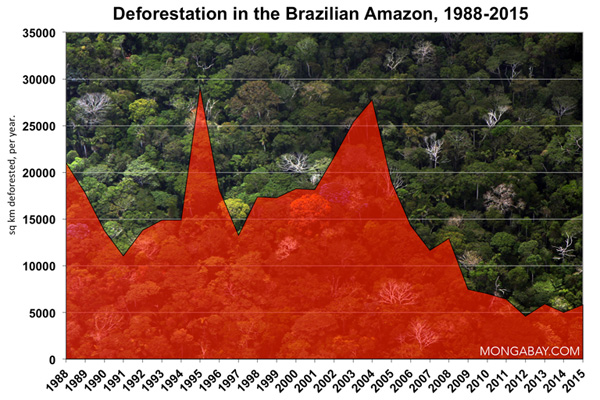
Deforestation across the Brazilian Amazon has fallen sharply since 2004. The drop is attributed to several factors including improved governance and law enforcement, new protected areas, macroeconomic trends, and increased concern among buyers about products linked to deforestation.
CITATION: Christoph Nolte, Arun Agrawal, Kirsten Silvius, Britaldo Soares-Filho. “Governance regime and location influence avoided deforestation success of protected areas in the Brazilian Amazon,” PNAS Mar 15, 2013. www.pnas.org/cgi/doi/10.1073/pnas.1214786110
Related articles
Does the presence of scientists help deter poaching and deforestation in protected areas?

(02/27/2013) While vast areas of wildlife habitat have been set aside in protected areas in recent decades, many reserves continue to suffer from illegal encroachment, logging, mining, and poaching. The recent spasm in elephant and rhino poaching within African parks merely underlines the problem. Intuitively, it would seem that scientists’ presence in a protected area would help safeguard it from illegal activities. But according to a new paper published in Trends in Ecology & Evolution, no one has definitively shown that to be the case.
Colombia to double the size of massive Amazon reserve to include uncontacted tribes’ land

(01/10/2013) Colombia may more than double the size of the remote and poorly-known Chiribiquete National Park to make it the biggest protected area in the Colombian Amazon, reports El Espectador. Chiribiquete best known for its unusual rock formations, including mesa-like tepuis and dramatic waterfalls, but also features at least 32 cave painting sites with some 250,000 drawings, making it a key center for indigenous culture.
New forest map shows 6% of Amazon deforested between 2000 and 2010

(09/21/2012) An update to one of the most comprehensive maps of the Amazon basin shows that forest cover across the world’s largest rainforest declined by about six percent between 2000 and 2010. But the map also reveals hopeful signs that recognition of protected areas and native lands across the eight countries and one department that make up the Amazon is improving, with conservation and indigenous territories now covering nearly half of its land mass.
Amazon tribes win support to protect 46 million ha of Amazon forest
(07/21/2011) Indigenous communities working to protect the Amazon rainforest got a boost last week with the launch of a “biocultural conservation corridor” initiative in two regions of Brazil.
Indonesia to recognize rights of forest communities, indigenous peoples
(07/12/2011) Indonesia will ‘recognize, respect and protect’ the rights of traditional forest users, including indigenous people, as it works to slow deforestation, reports the Rights and Resources Initiative, a coalition of NGOs.
Protected areas cover 44% of the Brazilian Amazon
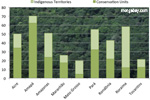
(04/20/2011) Protected areas now cover nearly 44 percent of the Amazon — an area larger than Greenland — but suffer from encroachment and poor management, reports a new study by Imazon and the Instituto Socioambiental (ISA). The report, published in Portuguese, says that by December 2010, protected areas in the Brazilian Amazon amounted to 2,197,485 square kilometers. Conservation units like national parks accounted for just over half the area (50.6 percent), while indigenous territories represented 49.4 percent.
Rainforests, wildlife preserved by indigenous spiritual beliefs
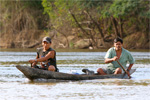
(11/15/2010) New research within the native Wapishana and Makushi communities of
Guyana suggests that indigenous cultural beliefs such as shamanism
help preserve tropical forests and wildlife. The analysis, published in the September 2010 Journal of Latin
American Geography, draws from a massive data set that tracks wildlife
populations, hunting kill sites, and spiritually significant features
of the landscape within a 48,000-square-kilometer area in southern
Guyana. The authors recruited the hunters themselves to record much of
the data.
New protected areas in Brazil contribute to major drop in Amazon deforestation rate
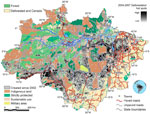
(06/01/2010) Protected areas in the Brazilian Amazon are proving highly effective in reducing forest loss in Earth’s largest rainforest, reports a new study based on analysis of deforestation trends in and around indigenous territories, parks, military holdings, and sustainable use reserves. The research, published in the early edition of Proceedings of the National Academy of Sciences, finds that 37 percent of the recent decline in deforestation in the Brazilian Amazon can be attributed to newly established protected areas. Brazil designated some 709,000 square kilometers (274,000 sq mi) of Amazon forest — an area larger than the state of Texas — between 2002 and 2009 under its Amazon Protected Areas Program (ARPA). Meanwhile deforestation in the Brazilian Amazon fell by nearly three-quarters between 2004 and 2009.
Brazil establishes 20,000 sq mi of new indigenous reserves in the Amazon
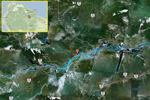
(12/23/2009) On Monday, Brazil decreed nine new indigenous reserves covering 51,000 square kilometers (19,700 square miles) of the Amazon rainforest, an areas larger than Denmark or Switzerland, reports the AFP. Five of the reserves are located in the state of Amazonas, two are in Pará, one is in Roraima, and another is in Mato Grosso do Sul. The protected areas house about seven thousand Indians from 29 ethnic groups, according to FUNAI (Fundação Nacional do Índio), Brazil’s indigenous affairs agency.
Google partners with Amazon tribe
(10/29/2009) The story of an indigenous Amazon tribe that has embraced technology in its fight to protect its homeland and culture is now highlighted as a layer in Google Earth.
New Amazonian reserve saves over a million acres in Peru

(08/30/2009) On August 27th Peru’s Ministry of the Environment approved the creation of the Matses National Reserve to protect the region’s biodiversity, ensure its natural resources, and preserve the home of the Matses indigenous peoples (known as the Mayorunas in Brazil). The park is 1,039,390 acres (or 420,626 hectares) of lowland Amazonian rainforest in eastern Peru. The park is the culmination of over a decade of work by the local non-profit CEDIA (the Center for the Development of the Indigenous Amazonians) funded in part by the Worldland Trust.
How to save the Amazon rainforest
(01/04/2009) Environmentalists have long voiced concern over the vanishing Amazon rainforest, but they haven’t been particularly effective at slowing forest loss. In fact, despite the hundreds of millions of dollars in donor funds that have flowed into the region since 2000 and the establishment of more than 100 million hectares of protected areas since 2002, average annual deforestation rates have increased since the 1990s, peaking at 73,785 square kilometers (28,488 square miles) of forest loss between 2002 and 2004. With land prices fast appreciating, cattle ranching and industrial soy farms expanding, and billions of dollars’ worth of new infrastructure projects in the works, development pressure on the Amazon is expected to accelerate. Given these trends, it is apparent that conservation efforts alone will not determine the fate of the Amazon or other rainforests. Some argue that market measures, which value forests for the ecosystem services they provide as well as reward developers for environmental performance, will be the key to saving the Amazon from large-scale destruction. In the end it may be the very markets currently driving deforestation that save forests.
Skoll Foundation puts $1M toward indigenous groups, conservation in the Amazon
(03/11/2008) The Skoll Foundation has awarded the Amazon conservation Team, an innovative organization the promotes biocultural conservation among indigenous groups in the Amazon, $1,015,000 to map, manage, and protect 100 million acres of rainforest. The award is one of 11 Skoll Awards for Social Entrepreneurship presented by the Skoll Foundation in 2008.
Experts: parks effectively protect rainforest in Peru
(08/09/2007) High-resolution satellite monitoring of the Amazon rainforest in Peru shows that land-use and conservation policies have had a measurable impact on deforestation rates. The research is published in the August 9, 2007, on-line edition of Science Express.
Brazil to give Amazonian tribes Internet access to fight deforestation
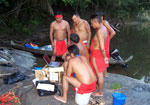
(03/30/2007) Brazil will offer free satellite Internet connections to indigenous tribes in the Amazon according to a report from Reuters. It says that the plan will help reduce illegal logging by enabling natives to monitor and report on illicit activities.
Amazon Indians use Google Earth, GPS to protect forest home

(11/15/2006) Deep in the most remote jungles of South America, Amazon Indians are using Google Earth, Global Positioning System (GPS) mapping, and other technologies to protect their fast-dwindling home. Tribes in Suriname, Brazil, and Colombia are combining their traditional knowledge of the rainforest with Western technology to conserve forests and maintain ties to their history and cultural traditions, which include profound knowledge of the forest ecosystem and medicinal plants. Helping them is the Amazon conservation Team (ACT), a nonprofit organization working with indigenous people to conserve biodiversity, health, and culture in South American rainforests.
Indians are key to rainforest conservation efforts says renowned ethnobotanist
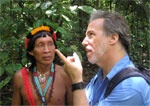
(10/31/2006) Tropical rainforests house hundreds of thousands of species of plants, many of which hold promise for their compounds which can be used to ward off pests and fight human disease. No one understands the secrets of these plants better than indigenous shamans -medicine men and women – who have developed boundless knowledge of this library of flora for curing everything from foot rot to diabetes. But like the forests themselves, the knowledge of these botanical wizards is fast-disappearing due to deforestation and profound cultural transformation among younger generations. The combined loss of this knowledge and these forests irreplaceably impoverishes the world of cultural and biological diversity. Dr. Mark Plotkin, President of the non-profit Amazon conservation Team, is working to stop this fate by partnering with indigenous people to conserve biodiversity, health, and culture in South American rainforests. Plotkin, a renowned ethnobotanist and accomplished author (Tales of a Shaman’s Apprentice, Medicine Quest) who was named one of Time Magazine’s environmental “Hero for the Planet,” has spent parts of the past 25 years living and working with shamans in Latin America. Through his experiences, Plotkin has concluded that conservation and the well-being of indigenous people are intrinsically linked — in forests inhabited by indigenous populations, you can’t have one without the other. Plotkin believes that existing conservation initiatives would be better-served by having more integration between indigenous populations and other forest preservation efforts.
Parks, indian reserves slow Amazon deforestation
(01/25/2006) A new study shows that parks and indigenous reserves in the Amazon help slow deforestation.














